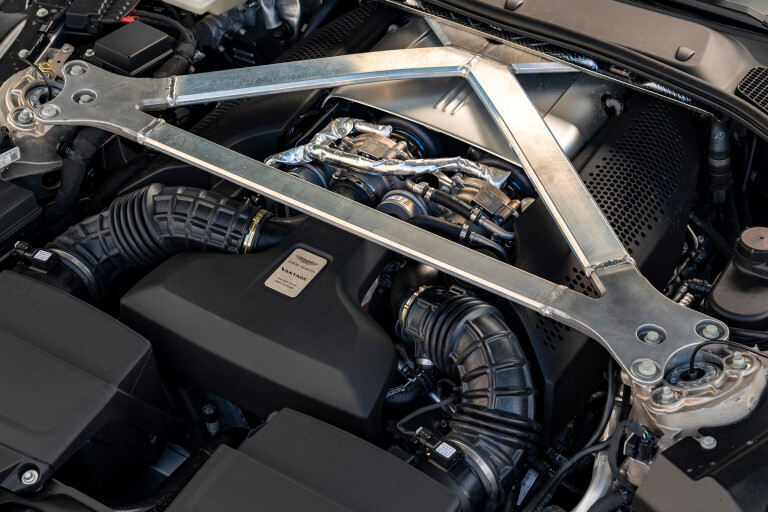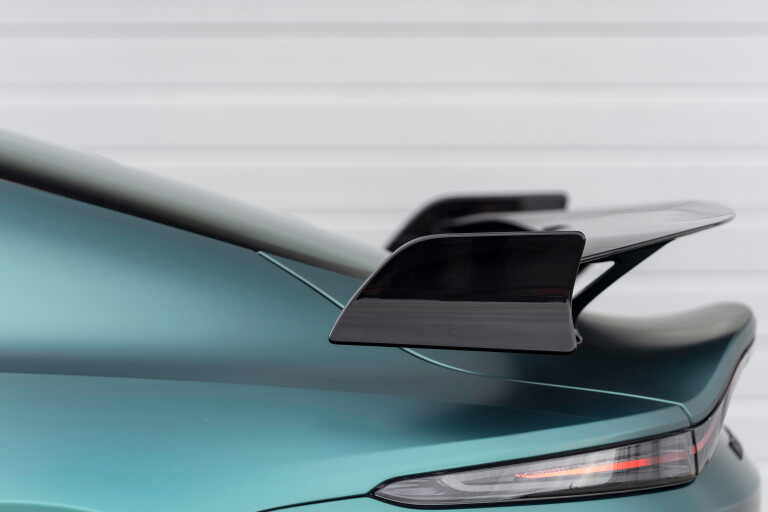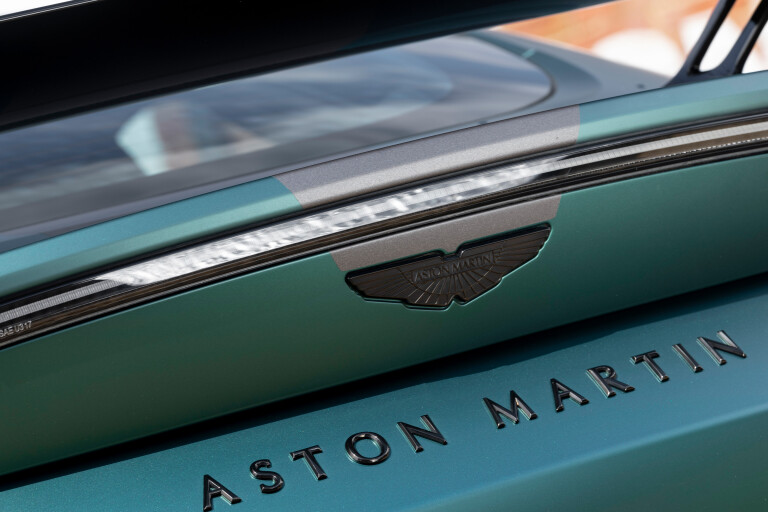
“A lot of people think it’s just wings, stripes and wheels,” says Aston Martin vehicle attribute engineering chief Matt Becker. “It’s more than that.”
Indeed. It’s the stuff you can’t see that makes the Aston Martin Vantage F1 Edition special. This is no quick-and-dirty marketing exercise created to celebrate Aston Martin’s return to Formula 1, but a car that’s been carefully tweaked to be quicker, more responsive, more rewarding than the regular Vantage.
It’s also the first Aston Martin developed under the direction of the company’s new boss, former AMG chief Tobias Moers.

Moers gave Becker a clear directive for the Vantage F1 Edition: It had to be quicker around the legendary Nürburgring Nordchliefe than the regular Vantage, and the improved lap time couldn’t simply be down to fitting better tyres. “I could have just put a set of [Michelin Pilot Sport] Cup 2s and job done,” admits Becker. “But he didn’t want that.”
Nor would Becker be able to rely on powertrain engineers extracting much more horsepower from the AMG-sourced 4.0-litre twin-turbo V8 that powers the regular Vantage. Though this hugely versatile engine happily makes 450kW in some Mercedes-AMG models, the Vantage F1 Edition would only get a mild five per cent power boost over the regular Vantage, to 393kW at 6000rpm, thanks to some software changes. Torque would remain the same, at 685Nm. Moers’ directive thus set in motion a host of detail changes to the chassis.
Moers gave Becker a clear directive for the Vantage F1 Edition: It had to be quicker around the legendary Nürburgring Nordchliefe than the regular Vantage

The front spring rate is the same as that of the regular Vantage, as is the compression rate of the front dampers, but the rebound damping rate has been increased by 18 per cent. Negative camber of the front wheels has been increased from 0.5 degrees to just over 1.0 degree. A shear panel under the front cross member has been thickened from 1.5mm to 3.0mm to provide a stiffer foundation for the entire front axle assembly and bushing on the steering column has been pinned to reduce on-centre compliance and deliver a more linear response to steering inputs.
At the rear, the upper control arms of the multi-link suspension now have stiffer bushes. The spring rate has been increased 10 per cent and the compression rate of the dampers upped 20 per cent. A lateral damper has been installed between the eight-speed automatic transaxle transmission and the rear subframe to control secondary motions of the transmission as the car changes direction.
The increase in wheel size on the F1 Edition – from 20-inch to 21-inch all round – isn’t just for show: While the compound of the larger diameter Pirelli P Zeros is the same as those on the regular Vantage, their different aspect ratio and construction deliver more lateral stiffness and thus quicker response. And the F1 Edition’s large front splitter, turning vanes and high-mounted, full-width rear wing are also strictly business. At speed, the base Vantage’s aerodynamics generate 50kg of downforce on the rear axle and a touch of lift at the front. But the F1 Edition generates 150kg of downforce at the rear and 60kg of downforce at the front.

It’s all textbook stuff for a chassis engineer chasing better balance, enhanced agility, and improved grip. And it works. Aston Martin sports car racer Darren Turner knocked about 15 seconds off the regular Vantage’s best lap time at the Nürburgring while testing the F1 Edition there earlier this year. But you don’t need to be a racing driver to feel the difference: The Vantage F1 Edition is noticeably more alert and communicative than the regular Vantage, even at legal road speeds.
Removing the compliance in the steering column means there’s more heft in the steering than in the regular car, and a more rapid response from the front axle that’s amplified by the stiffness in the front axle assembly and the sidewalls of the tyres. But, crucially, it’s not at the expense of feel; if anything, the dialogue between your fingertips and the tarmac is clearer and more concise than in the regular Vantage.

You notice the sharper, more authoritative front end almost immediately but the real magic is happening at the rear axle, which feels calmer and much more planted on the change of direction. The stiffer bushing in the upper control arms and the firmer and damper rates play their part, but, says Tobias Moers, damping the lateral motions of the transaxle-mounted eight-speed automatic transmission is key to making the whole car feel more composed and predictable under pressure. “You have always that issue of oscillation of the back end in a transaxle car,” says Moers. “We put everything together with what I know – with 12 years of transaxle cars – into the F1 Edition.”
The F1 Edition is very firm on the road, even with the suspension in its softest setting, but although the big heaves and hollows on Britain’s disintegrating B-roads excite plenty of abrupt vertical motions, the Aston’s ride feels less brittle than that of some AMG cars. “The British B-roads are different!” Moers acknowledges ruefully. “An Aston Martin should breathe a little bit.”
There’s just enough compliance in the system, more rubber mat than foam mattress, to make the F1 Edition livable as a daily driver.

It’s on the track, with the suspension and powertrain toggled to their most aggressive settings and the ESP switched all the way off, where you can really experience what makes the Vantage F1 Edition special. Yes, it’s more responsive, more awake than the standard car, but – more impressively – it also feels more coherent and composed as you start exploring its limits. You can trail brake into corners, feel the slip angles build, and use the throttle to easily find the balance you want. It’s not going to snap or spit or surprise you in any way, this Aston; the chassis telegraphs exactly what it’s going to do so you can always keep one step ahead.
And though on paper the power upgrade over the regular Vantage is negligible, in practice the F1 Edition engine feels stronger above 5000rpm and all the way to the 7000rpm redline. A subtle tweak to the eight-speed automatic transmission’s shift protocol helps: Instead of the engine management system cutting torque on upshifts to make them feel ‘sportier’ and induce some snap-crackle-pop from the exhaust, it’s now been tuned to ensure upshifts are as smooth and seamless as possible.

As well as new 21-inch wheels, F1 Edition comes standard with the blade grille that debuted last year as an option on the regular Vantage, plus quad exhaust outlets, and can be ordered in Coupé or Roadster format. Our test car was painted in the satin finish Aston Martin Racing Green. Other color options include Jet Black and Lunar White – in gloss or satin finish. The fully equipped interior – air-con, sat-nav, audio, power everything – is trimmed in dark leather and Alcantara, with a choice of lime green, black, grey, or red contrast stripes and stitching.
The Aston Martin Vantage F1 Edition is an object lesson in the art of chassis tuning. “It’s the sum of all the parts working together,” says Matt Becker of the way it drives, “which is what chassis tuning is all about.”
More importantly, though, the clear, no-nonsense product direction from Tobias Moers that made it happen signposts a promising future ahead for the iconic yet often troubled British brand.
2021 Aston Martin Vantage F1 Edition Specifications

| Engine | 3982cc V8, dohc, 32v, twin-turbo |
| Max Power | 485kW @ 6000rpm |
| Max Torque | 685Nm @ 2000-5000rpm |
| Transmission | 8-speed automatic |
| 0-100km/h | 3.5sec (claimed) |



COMMENTS